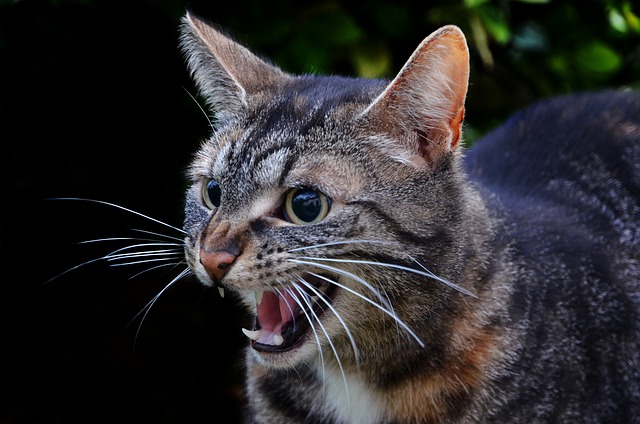While bringing a second cat at home is exciting for you, it is the opposite for your resident cat.
Well, in all honesty, both cats may hit it off in a matter of seconds—sneaking around, sleeping together, and playing with each other.
However, if your cats don’t seem to agree, don’t panic; you are in good company.
When two felines are introduced to each other for the first time, tempers are likely to flare.
Hissing and growling are expected for a few days or weeks before things cool down a bit.
Your old kitty doesn’t like another intruder and will act cold towards them.
It will take a while before the hissing, chasing, and stare contests go away and the cats learn to be friends.
These dramatic expressions can drive you up the wall. You are left to wonder when the hissing will stop and what is considered normal in the first place.
That’s where we come in. We will dish the entire scoop on determining normal and abnormal hissing concerning cat introductions.
Reasons Your Old Cat Hisses At the New Cat

There are plenty of reasons your resident cat won’t stop hissing at the new family member.
Here are some of them:
1. Sharing Is a Problem
After being the only furball in the house for a while, your resident cat has gotten used to being the boss around the home.
He does things his way and doesn’t have to share meals, treats, toys, and litter boxes.
When a new cat is introduced, the resident will be reluctant to share anything.
To solve the problem, make sure you have enough resources to go around before bringing the new kitty.
II. Territory Issues
Cats are territorial creatures. They don’t fancy the idea of having another kitty in their environment because it threatens their security and that of their owners.
III. Change in the Routine
Cats easily get confused and anxious when their daily routines are disrupted by a new pet.
They express their feelings by hissing and being aggressive.
The best thing would be to keep your cat’s schedule and routine to ease anxiety.
IV. Too Much Energy
Another reason one cat hisses at another is perhaps because he has lower energy and cannot keep up with the active nature of his counterpart.
When choosing a kitten, try to match her energy with that of the resident cat.
V. Bullying
Apart from energy levels, the temperaments of the cats also influence how the introduction will go.
If one kitty has the habit of blocking exit points or resources, there will be tension and ultimately hissing and growling.
What Hissing Is Normal (And What Is Not)?

Firstly, let’s establish the fact that hissing is normal when it comes to feline introductions.
Hissing is a form of communication that tells you or another cat to back or risk being attacked.
If you know a thing or two about cats, you understand that they don’t like confrontations and will do anything to avoid them. Hissing then is a warning shot that is aimed at telling you to stay away.
Anti-cruelty published a detailed article on the issue of cat introduction claiming that hissing that goes beyond 2 minutes at a time should be taken as a sign of trouble.
This is especially true if it is accompanied by other red-flag signs such as heavy swatting, screaming, chasing, and flattened ear postures.
Apart from the time it takes for the cats to hiss down at each other, the length of days the hissing goes on also shows how well (or otherwise) the meeting is going.
Ideally, if you encounter no hissing within the first week of having the new cat at home, feel free to let the cat mingle without any doors or barriers between them.
Serve some yummy treats and watch how they behave around each other.
A little hissing is absolutely normal and expected. Intervene only if the hissing goes on for over two minutes and the cats show full-on aggression. Once things calm down, try again.
However, if the hissing goes on for more than one week, don’t allow the cats to exist in one room. Instead, put a barrier between the felines and keep feeding treats.
If one cat refuses to feed, move the bowl far away to a secure place. If the kitties remain calm, praise them and keep doing that until the tension dies down completely.
Then and only then can you let them meet without barriers.
Additional Tips
Hissing can progress longer than expected or take a short time depending on the personality of your cats, energy levels, among other things.
While you cannot do anything about those, some factors are in your control.
Here are some of the things you can do to make cat introductions go well.
- Don’t Throw The Cats In One Room From The Word Go: Some parents believe that when you bring a new cat home, the best way to let him meet the old cat is to let them share a room and figure their relationship out. While this principle works sometimes, it can also backfire on you terribly. In addition to the risk of letting the dogs fight to the point of injuring each other badly, one or both kitties may be emotionally affected for the rest of their life.
Related Post: How Long Should You Keep A New Cat In One Room?
- Offer Love and Attention to Your Resident Cat: Both cats deserve your attention but the old one needs more of it to be assured that he’s not been replaced.
- Ignore Normal Hissing: It is tempting to want to punish cats that want to tear each other apart. However, resist the temptation at all costs. Punishing will only exacerbate the behavior.
Parting Thoughts
Hissing may be a normal outcome when two cats are introduced to each other for the first time but it can also get out of hand.
When it does, it means the pets need more time away from each other.
If hissing doesn’t happen for a week, you are successful in your efforts. Otherwise, let the cats be separate for longer.
Related Posts:
Cat Depression After New Kitten: Does It Exist? (Plus How to Deal with It)
When Should You Leave a New Cat Alone with Resident Cat?

Hi! I am Eleanor Price. I started this website after my cat, Louie, almost died from a case of botulism (a type of food poisoning often caused by bacteria that grow on food items). Turned out that my cat’s diet was the problem. I have made it my duty to provide the best information and recommendations about everything cat lovers need to know about their felines’ health and wellbeing. My goal is to find the most informative content on anything feline-related and share it with fellow hardworking kitty lovers.

